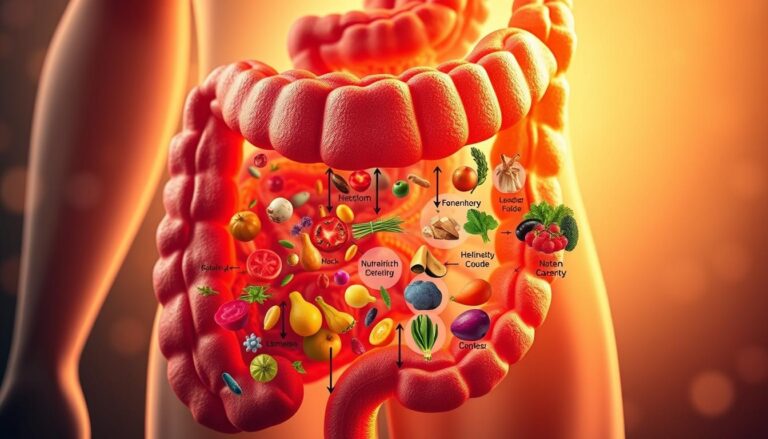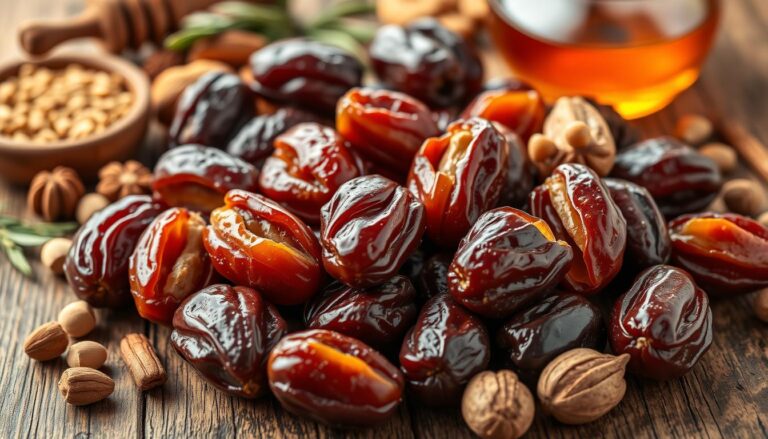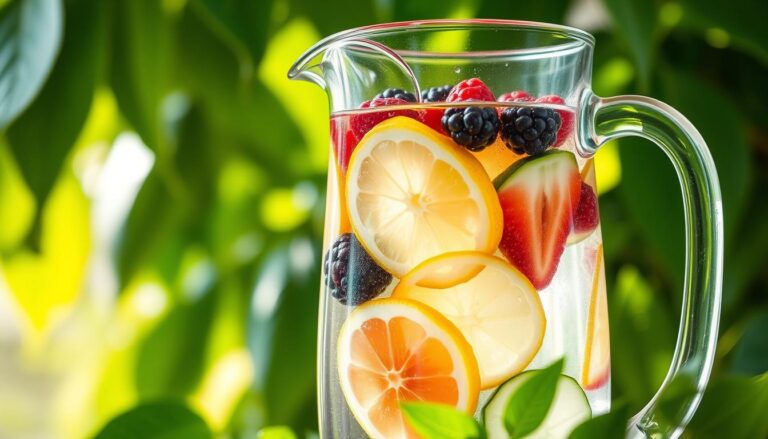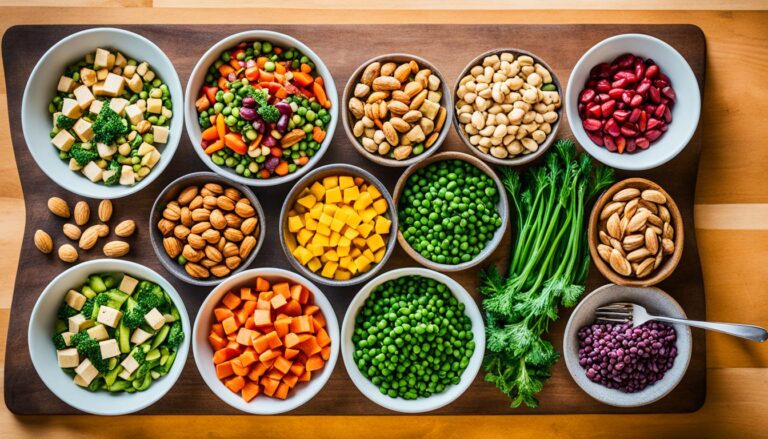Can a high-protein diet truly transform fitness results without compromising taste or convenience?
Many struggle to meet elevated protein needs while keeping meals enjoyable and calorie conscious. This guide simplifies the process with science backed strategies.
Protein plays a vital role in muscle repair, metabolic health, and overall wellness. Yet hitting 150 grams daily demands careful planning. Diverse sources from lean meats to plant based alternatives offer flexibility for every preference.
Balancing macros and managing portion sizes becomes effortless with structured meal plans. Whether prioritizing animal or plant-derived options, achieving this target is both practical and sustainable.
Key Takeaways
- Protein supports muscle growth and fat loss effectively.
- Variety in sources ensures nutritional balance.
- Meal planning prevents calorie overload.
- Combining animal and plant-based options maximizes intake.
- Supplements can help bridge gaps when whole foods fall short.
Why 150g of Protein Daily Supports Your Health Goals
Science confirms protein’s dual role in muscle repair and fat loss. For active adults this macronutrient is essential for achieving fitness milestones and sustaining metabolic health. Structured intake aligns with long-term wellness goals.

Muscle Growth and Recovery
Protein provides amino acids to rebuild damaged fibers post workout. Research suggests 150g daily optimizes muscle synthesis especially when paired with resistance training. Active individuals experience faster recovery and reduced soreness.
Incomplete plant-based proteins e.g. beans require strategic pairing like rice to deliver all essential amino acids. This ensures efficient tissue repair without gaps in nutrition.
Weight Management and Satiety
High-protein diets elevate thermogenesis, burning more calories during digestion. They also suppress ghrelin, the hunger hormone, reducing cravings. Studies link protein-rich meals to prolonged fullness, aiding weight control.
Contrary to myths moderate protein intake doesn’t harm kidneys in healthy individuals. Balanced portions support metabolism without overburdening organs.
Animal Based Protein Powerhouses
Lean animal proteins deliver high bioavailability for muscle synthesis. These sources provide all essential amino acids making them ideal for fitness and recovery. With precise portions they help meet elevated needs without excess calories.

Read more: Fiber Polyphenols Lean Protein Blood Sugar Boost
Chicken Breast Lean and Efficient
Skinless chicken breast offers 23g of protein per 100g with minimal fat. Grilling or baking preserves nutrients better than frying. Pair with quinoa or roasted veggies for a balanced meal.
Eggs and Egg Whites Budget Friendly Staples
Whole eggs contain 6g of protein, while egg whites provide 3.5g per white. They’re versatile scramble boil or use in omelets. A 12-egg daily plan meets nearly half the target intake.
Animal proteins like eggs and chicken score highest in PDCAAS Protein Digestibility Corrected Amino Acid Score ensuring optimal muscle repair.
Fatty Fish Protein with Heart Benefits
Salmon and tuna deliver 22g of protein per 100g serving, plus omega-3s. Bake or steam to retain healthy fats. Canned tuna is a convenient shelf-stable option.
| Protein Source | Protein per 100g | Best Cooking Method |
|---|---|---|
| Chicken Breast | 23g | Grilling |
| Egg Whites | 3.5g per white | Boiling |
| Salmon | 22g | Baking |
- Prioritize grilling or baking to avoid added fats.
- Combine eggs with veggies for fiber-rich meals.
- Opt for wild-caught fish to maximize omega-3 content.
Plant Based Protein Champions
Meeting protein needs without meat is achievable with smart food choices. Plant based protein sources like lentils soy, and beans provide robust alternatives for muscle growth and satiety. Strategic pairings ensure complete amino acid profiles.

Lentils The Fiber Rich Powerhouse
Green moong lentils deliver 22g of protein per 100g soaked. Pairing them with rice or grains creates a complete amino acid chain. This combo supports muscle repair and energy levels.
Chickpeas and Kidney Beans Versatile Staples
Chickpeas offer 9–10g of protein per 100g, plus iron and magnesium. Blend into hummus or toss into salads. Kidney beans shine in spiced curries with quinoa for a balanced meal.
Moderate soy consumption 50–80g/day shows no adverse hormonal effects in recent meta analyses.
Soya Chunks: Budget Friendly Protein
With 52g of protein per 100g, soya chunks are a cost-effective choice. Use in stir-fries or stews, but limit to 50–80g daily to avoid overconsumption.
- Pair lentils with brown rice for amino acid balance.
- Roast chickpeas with spices for a crunchy snack.
- Choose gluten-free grains like quinoa for sensitive diets.
Dairy and Supplements for Convenient Protein
Dairy and supplements offer efficient ways to boost daily intake without elaborate meal prep. These options provide flexibility for busy lifestyles while ensuring optimal muscle support.
Whey Protein The Gold Standard
Whey protein like BigMuscles Nutrition, delivers 24g per scoop with all essential amino acids. Its rapid absorption makes it ideal for post-workout recovery. Studies show it enhances muscle synthesis when combined with resistance training.
Greek Yogurt and Cottage Cheese
Greek yogurt packs 15g of protein per 150g serving plus gut-friendly probiotics. Cottage cheese provides 12g per ½ cup, rich in slow-digesting casein. Both are versatile blend into smoothies or pair with fruit.
Casein’s gradual digestion rate makes it superior for overnight muscle repair.
Plant Based Alternatives
For lactose intolerance, pea or hemp protein shakes offer comparable benefits. Pea protein contains 20g per scoop, while hemp adds omega-3s. Combine with almond milk for a creamy texture.
| Source | Protein per Serving | Best Use |
|---|---|---|
| Whey Protein | 24g | Post-workout |
| Greek Yogurt | 15g | Snacks/breakfast |
| Pea Protein | 20g | Lactose-free shakes |
- Prioritize whey within 30 minutes post-exercise for rapid recovery.
- Choose full fat Greek yogurt for added satiety.
- Casein before bed sustains amino acid levels overnight.
Sample High Protein Meal Plan 150g/Day
Structured meal plans simplify hitting 150g of protein daily while keeping calories in check. This 1,523-calorie blueprint balances macros and prioritizes nutrient density. Each meal is designed for efficiency from muscle-fueling breakfasts to recovery focused dinners.

Read more: Do Fried Eggs Make You Fat?
Breakfast Egg White Omelet with Veggies
Start with 1 cup of egg whites (30g protein) paired with turkey and spinach. This 326-calorie meal digests quickly providing amino acids for morning energy. Add bell peppers for fiber and vitamin C.
Lunch BBQ Chicken Salad with Beans
A 491-calorie bowl combines grilled chicken, black beans, and avocado. Ranch dressing adds healthy fats while beans contribute 15g of plant-based protein. This keeps carbs moderate 34g for sustained energy.
Dinner: Shrimp Pasta with Zucchini Noodles
Zucchini noodles reduce starch without sacrificing volume. Shrimp delivers 40g of protein, and a side salad boosts micronutrients. Total dinner calories: 415.
Snack Options
- Protein shakes 19g/serving for post-workout recovery.
- Cottage cheese with berries for slow digesting casein.
Adaptations are simple: swap shrimp for tofu in vegan versions or use Greek yogurt instead of ranch. Flexibility ensures sustainability.
Tips to Hit 150g Protein Without Overeating
Strategically combining food sources makes reaching high protein targets manageable while controlling calorie intake. A balanced protein diet focuses on nutrient density while avoiding unnecessary fat accumulation. These methods ensure a sustainable approach to muscle support.

Lean Proteins for Calorie Control
Choosing skinless poultry white fish, and egg whites maximizes protein with minimal calories. These options deliver 20-30g per serving while keeping meals light. For example, swapping ribeye steak for grilled chicken breast saves 150 calories per 100g portion.
Participants consuming lean proteins maintained 28% greater calorie deficits in weight loss studies versus high-fat protein groups.
Strategic Supplementation
Quality protein shakes bridge gaps between meals efficiently. Clean Simple Eats’ brownie batter flavor offers 24g per scoop with minimal additives. Limit to 1-2 servings daily to maintain whole food focus.
Smart Plant Protein Pairings
To include diet variety, combine complementary plant sources:
- Brown rice + black beans complete amino acid profile
- Whole grain toast + almond butter balanced macros
- Quinoa + chickpeas fiber and protein synergy
Tracking apps like MyFitnessPal help monitor ratios without guesswork preventing accidental overconsumption of processed alternatives.
Conclusion Building Your 150g Protein Diet
Balanced nutrition and smart planning make high-protein goals attainable. Combining lean meats, plant-based sources, and supplements ensures consistent intake without excess calories. Start small add a protein shake or Greek yogurt snack to daily routines.
Tools like Eat This Much simplify personalized meal plans, while tracking apps prevent guesswork. Occasional deviations won’t hinder progress; consistency matters more than perfection. For tailored advice, consult a nutritionist to align intake with activity levels and health needs.
A 150g protein diet fuels muscle growth and metabolic health effectively. With strategic choices, this target becomes sustainable one day at a time.





